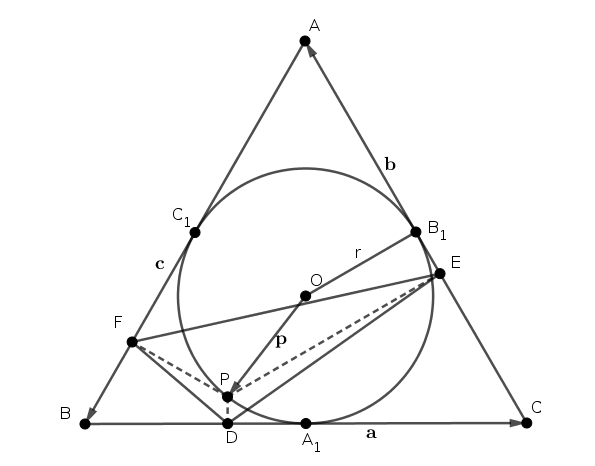 Problem B. 5096. (April 2020)
Problem B. 5096. (April 2020)
B. 5096. In a regular triangle \(\displaystyle ABC\) of unit sides, let \(\displaystyle P\) be an arbitrary point on the circumference of the incircle. Let \(\displaystyle D\), \(\displaystyle E\), and \(\displaystyle F\) denote the orthogonal projections of point \(\displaystyle P\) on the sides \(\displaystyle BC\), \(\displaystyle AC\) and \(\displaystyle AB\), respectively. Prove that the area of triangle \(\displaystyle DEF\) is a constant, independent of the choice of \(\displaystyle P\).
(4 pont)
Deadline expired on May 11, 2020.
Sorry, the solution is available only in Hungarian. Google translation
Megoldás. Használjuk az ábra jelöléseit, legyenek az oldalvektorok \(\displaystyle \overrightarrow{AB}=\mathbf c\), \(\displaystyle \overrightarrow{BC}=\mathbf a\) és \(\displaystyle \overrightarrow{CA}=\mathbf b\); nyilván \(\displaystyle |\mathbf a|=|\mathbf b| = |\mathbf c|= 1\). Legyen továbbá \(\displaystyle \overrightarrow {OP}=\mathbf p\), ahol \(\displaystyle |\mathbf p|= r=1/(2\sqrt 3)\) a beírt kör sugara.

A skaláris szorzat geometriai jelentése szerint az \(\displaystyle \mathbf a \mathbf p\) skaláris szorzat éppen az \(\displaystyle A_1D\) szakasz előjeles hossza, így \(\displaystyle BD=BA_1\pm A_1D=1/2+\mathbf a \mathbf p\). Hasonlóan látható, hogy \(\displaystyle DC=1/2-\mathbf a \mathbf p\); \(\displaystyle CE=1/2+\mathbf b \mathbf p\); \(\displaystyle EA=1/2-\mathbf b \mathbf p\); \(\displaystyle AF=1/2+\mathbf c \mathbf p\) és \(\displaystyle FB=1/2-\mathbf c \mathbf p\).
A \(\displaystyle DEF\) háromszög területét megkapjuk, ha az \(\displaystyle FBD\), \(\displaystyle DCE\) és \(\displaystyle EAF\) háromszögek területeinek összegét levonjuk az \(\displaystyle ABC\) területéből.
$$\begin{align*} & T_{BDF}+T_{DCE}+T_{EAF}=\frac{BD \cdot BF\cdot \sin 60^\circ}{2}+\frac{CD \cdot CE\cdot \sin 60^\circ}{2}+\frac{AE \cdot AF\cdot \sin 60^\circ}{2}=\\ & = \frac{\sqrt 3}{4}\left [(1/2+\mathbf a \mathbf p)(1/2-\mathbf c \mathbf p)+(1/2-\mathbf a \mathbf p)(1/2+\mathbf b \mathbf p)+(1/2-\mathbf b \mathbf p)(1/2+\mathbf c \mathbf p) \right ]=\\ & =\frac{\sqrt 3}{4}\left [\frac 34 - \left ((\mathbf a \mathbf p)(\mathbf b \mathbf p)+(\mathbf a \mathbf p)(\mathbf c \mathbf p)+(\mathbf b \mathbf p)(\mathbf c \mathbf p) \right )\right ] \end{align*}$$Ha \(\displaystyle \mathbf p\) és \(\displaystyle \mathbf a\) bezárt szöge \(\displaystyle \theta\), akkor \(\displaystyle \mathbf p\) és \(\displaystyle \mathbf b\) szöge \(\displaystyle \theta +120^\circ\), valamint \(\displaystyle \mathbf p\) és \(\displaystyle \mathbf c\) szöge \(\displaystyle \theta +240^\circ\), hiszen az \(\displaystyle \mathbf a\), \(\displaystyle \mathbf b\) és \(\displaystyle \mathbf c\) vektorok egymás \(\displaystyle \pm 120^\circ\)-os elforgatottjai. Így
$$\begin{align*} &(\mathbf a \mathbf p)(\mathbf b \mathbf p)+(\mathbf a \mathbf p)(\mathbf c \mathbf p)+(\mathbf b \mathbf p)(\mathbf c \mathbf p)=r^2(\cos \theta \cos (\theta +120^\circ)+\cos \theta \cos (\theta +240^\circ)+\cos (\theta +120^\circ)\cos (\theta +240^\circ))=\\ & =r^2\left [ \cos \theta\left ( \frac{-\cos \theta}{2}-\frac{\sqrt 3 \sin \theta}{2} \right )+ \cos \theta\left ( \frac{-\cos \theta}{2}+\frac{\sqrt 3 \sin \theta}{2} \right )+\left ( \frac{-\cos \theta}{2}-\frac{\sqrt 3 \sin \theta}{2} \right ) \left ( \frac{-\cos \theta}{2}+\frac{\sqrt 3 \sin \theta}{2} \right ) \right ]=\\ &= r^2\left (\frac {-3\cos^2 \theta}{4}+\frac {-3\sin^2 \theta}{4} \right )=\frac 1{12} \cdot \frac {-3}4=\frac {-1}{16}, \end{align*}$$ahol a számolásban felhasználtuk a koszinusz függvény addíciós formuláját. Innen pedig
\(\displaystyle T_{DEF}=T_{ABC}-(T_{BDF}+T_{DCE}+T_{EAF})=\frac{\sqrt 3}{4}-\frac{\sqrt 3}{4}\left (\frac 34+ \frac 1 {16} \right)=\frac{3\sqrt 3}{64},\)
ami valóban \(\displaystyle P\)-től független állandó.
Statistics:
40 students sent a solution. 4 points: Balogh Ádám Péter, Bán-Szabó Áron, Baski Bence, Beinschroth Ninett, Beke Csongor, Czett Mátyás, Fekete Richárd, Fleiner Zsigmond, Füredi Erik Benjámin, Gábriel Tamás, Hervay Bence, Kerekes Boldizsár, Koszta Benedek, Nagy 551 Levente, Németh Márton, Seres-Szabó Márton, Somogyi Dalma, Szabó 991 Kornél, Terjék András József, Tiderenczl Dániel, Tóth 057 Bálint, Vakaris Klyvis. 3 points: Al-Hag Máté Amin, Andó Viola, Fey Dávid, Hámori Janka, Laki Anna, Lengyel Ádám, Lovas Márton, Mácsai Dániel, Molnár Lehel, Móricz Benjámin, Osztényi József, Velich Nóra. 2 points: 3 students. 1 point: 1 student. 0 point: 2 students.
Problems in Mathematics of KöMaL, April 2020
